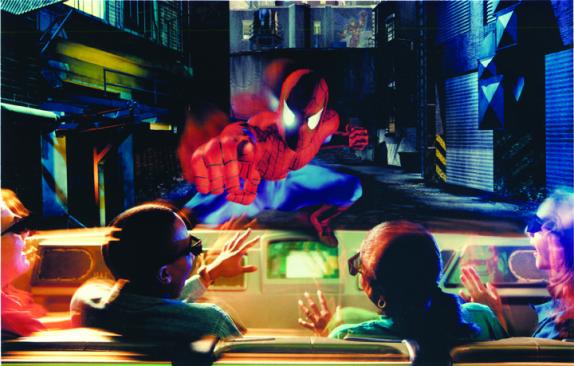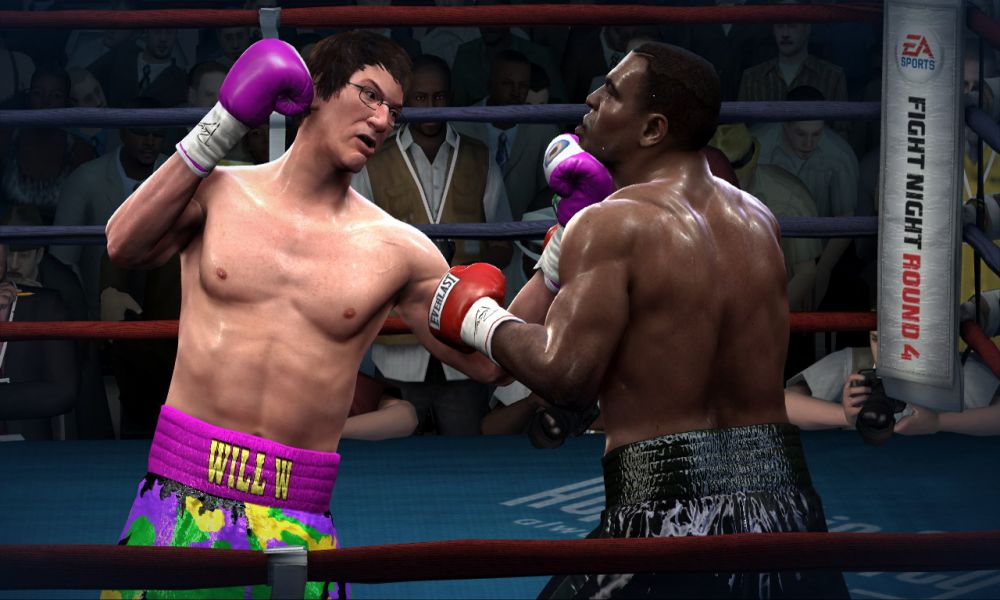Meant to be Seen is very honored to be joined by Frank Vitz, Senior Art Director and CG Supervisor for Electronic Arts. As this interview will demonstrate, Frank has earned a name for himself at every stage of his career. He cut his teeth on the first Tron movie, worked on the special effects for the first two X-Men movies, and is a respected pioneer and inventor in the gaming industry. Just about everyone has been touched by Frank’s work - including Spider-Man in stereoscopic 3D!

Frank Vitz, Senior Art Director and CG Supervisor for Electronic Arts
Hi Frank! Before we talk about your video game work, let’s talk about your early days. I understand you started off studying physics at Occidental College, but had a change of heart. What happened?
Well, those were my formative years I guess you could say… It wasn’t so much a change of heart as it was a realization that I would never be a pure scientist… the place where I belonged was at the intersection of art and science, whatever that means.
I have always loved making new things that do something, usually something visual, and I found that the Physics department at Occidental at that time was not very open to experimentation (physics majors in those days appeared to be mostly slide rule toting pocket protector nerds actually), whereas the Art department was very supportive of my technical approach to art. So I switched majors! But both departments at least tolerated my crazy ideas… I did things like borrow the Krypton Argon laser from the physics department to create a live laser light show, something that was pretty new at the time.
I wouldn’t be exaggerating if I said you had a very colorful early career. What work did you do on the movie Tron, and who is this "sexy robot" I keep hearing about?
Big jump cut from Occidental to Hollywood! But I did a lot of interesting things that led to my working at Robert Abel and Associates in Hollywood right when Tron went into production. We were one of a very few companies able to do computer graphics on a big screen in those days (We wrote our own software, built our own camera systems and even our own film recorder). We had a very cool vector graphics process based on Evans and Sutherland machines. We landed the job of creating a trailer and then the opening titles for Tron. That job expanded into creating what we called “Flynn’s Ride” which is the sequence in the movie where Kevin Flynn gets digitized and sucked into the game world. We knew even then that what we worked so hard to create would soon look primitive, but we also knew that it was the start of something big.
Sexy Robot came after Tron… it was our name for the futuristic “Brilliance” commercial we produced for the Canned Food Council (very forward thinking of them!). This was one of the first commercials produced with Abel’s new proprietary 3D software that we had invented. Sexy Robot was exactly that; a beautiful chrome female robot who extolled the virtues of food stored in cans! She featured a primitive form of motion capture, hierarchical skeletal animation, texture and reflection mapping, procedural animation; lots of new stuff that we take for granted today.
In my research, I learned that Jeffrey Kleiser also worked on Tron. Did your paths cross there? How did you get connected?
Jeff Kleiser was working on Tron at Digital Effects at that time and our paths did cross and we hit it off, but it was not until later that we started working together. After Omnibus imploded, dragging Robert Abel and Associates and Digital Productions under, I went independent. I helped Jeff on some of his earliest “Synthespian” projects; Dozo was an early example of Mocap driven character animation.
Kleiser-Walczak, The Kleiser-Walczak Construction Company..."Special Effects Duo", "Power Couple", "the mystique behind Mystique"...how would you classify them? Tell us about Kleiser-Walczak!
Jeff and Diana are like the Digital Renaissance Couple. Technically savvy, driven by lofty artistic goals and always willing to take financial and creative risks; they are exactly my style and great to work with. And they are both musicians too! Diana is classically trained on piano and Jeff is a drummer; he plays with my band when he visits Vancouver! Just amazingly creative people.

Mystique in mid-transformation from X-Men
Mystique, Rebecca Romijn, CG...how did Frank Vitz fit into the equation? Can you describe the leading innovations you came up with for the first and second X-Men movies?
I was the VFX Supervisor for the Kleiser Walczak team on the first two X-Men movies. With the work we had done at KWCC on the Stargate mecho-morphs and digital stunt doubles in Judge Dredd, we were well positioned to take on the Mystique transformations on X-Men. Mystique is a shape shifter and we developed a cool 3D morphing system that allowed us to create a very organic progressive transformation that stood apart from the 2D morphing that was all the rage at the time. I also worked with Paul Debevec to develop a workflow that incorporated high dynamic range (HDR) images to help composite our synthetic images of Mystique seamlessly into the live action scenes.
KW is well known for stereoscopic 3D productions. I’ve seen their S-3D film "Santa Lights Up New York" for Radio City Music Hall, for example. Let’s talk about another man who prances around the city in a red and black suit. I hear you know this guy?
Yes, KW has done quite a few S-3D projects and one of the biggest was the Spider-Man ride at Universal Studios in Orlando! What a project that was! It’s what they call a Dark Ride or a Ride Film… with computer controlled cars moving along a track through big sets. Spider-Man is a full bore 3D adventure in 70mm with 13 big screens. At KWCC we produced all the stereoscopic visual content as computer animation. I was the Visual Effects Supervisor on the project.

Spider-Man in Stereoscopic 3D!
Can you talk about the mechanics of the ride? Without giving too much away, what is the experience like? Can you describe some of the equipment that makes it all go?
The Spider-Man ride is a wonder of high tech wizardry. There is a very sophisticated computerized show control system that coordinates multiple ride vehicles simultaneously moving through a series of complex sets. The system controls the motion of the cars, the lighting, sound track, visual effects and most importantly, a series of stereoscopic movies on big screens triggered at the appropriate time for each car as they pass by. The 3D movies draw the audience into the illusion that they are actually there, sharing in Spider-Man’s adventure.
I understand that "The Amazing Adventures of Spider-Man" proved to be more adventurous than anticipated! With modern S-3D cinema, movie makers are challenged to find the best levels of separation and convergence for an audience that sits still. Can you explain how this compares to the challenges of following Spider-man’s amazing adventure in a moving environment?
That was a BIG challenge… and unlike in a theater, the idea of the ride is that it is supposed to be seamless immersive world… you can’t tell where the sets end and the movie screen begins… so the challenge in creating the stereoscopic animation was to not only make it look dimensional, but also to make it fit into the real world measurements and sight lines of the vehicles moving through the sets. We built a computer simulation of the entire ride and scaled all of our animation so that it would converge properly and appear in the right space from the audience’s point of view. For example at one point you come around a corner in your vehicle and look down the street between two real buildings… the movie screen spans across between the two buildings and your view of the building and the alley continues into the screen. Our CG Spider-Man appears to swing in on his web between the two buildings, land on a real physical sign and then jump right onto the front of your vehicle! Pretty cool.
The idea of carts of people moving from screen to screen with jumps and bumps - how did you keep the 3D illusion alive?
You bring up a good point. Normal theatrical stereoscopic projection is designed to be seen from a fixed point of view. It looks foreshortened if you sit off to either side of the centerline in the theater, but because you don’t move, your brain gets used to the distortion, adapts and accepts it. But if you move at all relative to the screen, it becomes immediately obvious that what you are looking at is a projection. In the case of the Spider-Man ride we happen to know exactly how the viewer will be moving because he is sitting in a computer controlled ride vehicle. What we did was to invent a way to correct for the distortion introduced by a moving point of view. In fact I developed several image processing algorithms to achieve this effect that taken together we called “squinching”. It’s a lot of weird math, but the visual effect on the screen is that you are looking through a window at a real place.
Maya is currently the main-stay of game development and CG animation. I understand that your team switched the software back-end to an early beta version of Maya in the middle of production. What were you thinking?!?
I know, it sounds crazy, doesn’t it? But, we were working directly with Alias Wavefront at the time; contributing to the design of the new Maya software, and they were building into it stuff that we needed desperately in order for some of our ideas to even work at all. So we took a calculated risk and characteristically jumped in with both feet. Luckily it paid off!
Tron Legacy is due out late 2010, a stone throw away from thirty years since the original in 1982! This time, in addition to being modernized with CG graphics that are generations ahead of its predecessor, it is going to be shown to audiences in stereoscopic 3D. What are your thoughts? Do you think the original Tron would be visually interesting in stereoscopic 3D? Why or why not?
I have been looking forward to a sequel to Tron for years and always imagined that it would be great to work on it in some capacity, but I have been too busy to pursue any involvement.
I have also often thought that it would be cool to revisit the original Tron and update it, similar to what Lucas did with the original Star Wars episodes. It would be great to get rid of the pops and matte lines… rework some of the worst shots. There has already been a DVD release with a re-mastered digital sound track, but it would be tempting to re-do the graphics entirely (we can do a better job in real time on a game console today than we could off line with a room full of VAX computers in 1982!) but then that would sort of ruin the historical context of the original film, kind of like colorizing old black and white films; which I don’t usually like. Oh well, not for me to decide anyway. Now that you mention it though, I think the film would be fun in stereoscopic 3D; you could limit the S-3D to the game world for example, to give it additional visual pop and separation from the live action portion of the movie.

Tackle Lift image is from MPulse physics driven animation project at EA World Wide Visualization Group
You jumped to Electronic Arts in 2003. Why the change from cinema and theme parks to video games?
I had been noticing for years how video games were catching up to the movies in digital visual effects techniques and I was predicting that video games would even overtake film! Of course a lot of people were saying similar things, but Glenn Entis learned of my interest in games and offered me a chance to help make it so with a job at EA, applying my knowledge of computer animation to games right at the transition to the latest generation of gaming consoles. What a great opportunity to switch industries right at a pivotal moment! As usual I jumped right in!
It seems that every step of your career is about inventing something new. Can you describe your R&D role at EA, and some of the innovations you came up with? Are these techniques being used by other game developers too?
Glenn Entis charged me with setting up a small Advanced Concepts Development Group at EA’s studio in downtown Vancouver. Our goal was to apply techniques and visual styles developed in the film industry to the new generation of games and hopefully share them out across multiple titles amongst EA’s many studios worldwide. A daunting challenge in hindsight, but hey, it still sounds like a good idea! We worked on the application of cinematic techniques to game play, lighting, camera choreography, character performances and visual effects. We produced concept videos, created real time hardware and software demos and developed production software tools. It was heady stuff. At its zenith our Visualization Group had projects underway in facial performance capture, procedural animation, physics driven character animation, unified skeletal rigs, advanced real time shaders and a lot of other stuff. Many of these techniques took several years to come to fruition but because we worked directly with game team software engineers, they were able to carry the work forward and you can see the results in many EA games today. The video game industry is also very fluid with people moving around from company to company and sharing their ideas at places like GDC and SIGGRAPH. Our work drew from and is part of the CG zeitgeist now.

Will Wright vs. Tyson from the special Fight Night 4 build shown at SIGGRAPH 2009
You were later transitioned to video game production, and your current title is Senior Art Director/CG Supervisor. Can you describe some of the projects that cross your desk? How would you contrast the gaming industry to your earlier work?
In what I think was a short sighted move several years ago, EA shut down most of its centralized research and development and many projects were eliminated, including my whole group. It was very discouraging because we had so much promising work underway, but then I saw it as an opportunity to jump into game production and went for it. I have since worked on several different game teams. Of course I am no stranger to production and there are always opportunities for invention and innovation in the trenches… that is where we most often do it! This past year I worked on Fight Night Round 4 which pushes the envelope in physics driven animation and visuals. I was very proud to show it live in the Electronic Theater at Siggraph in New Orleans this past summer.
We recently met in person, and for the first time, you saw EA’s Need For Speed SHIFT running in stereoscopic 3D on an LG 3D HDTV. When you sat down in front of that television and started to race in true 3D for the first time, what was going through your mind?
I was thinking, WOW this is smooth and seamless! The 3D is as good as in the big theaters. It felt like I was really inside the car on the track. It did not feel contrived or like an afterthought. I was thinking, this is the future of video game visuals.
In the case of The Amazing Adventures of Spider-Man, the S-3D experience was obviously critical to the ride’s success. You even invented the "squinching" technique to make it work properly. Artistically, should video games get the same S-3D benefits as your amusement park ride? Why or why not?
Absolutely. While S-3D is not essential to making a great game, just like color is not essential to making a good movie, it DOES add another big dimension to the artistic palette available to the game makers in their craft. S-3D coupled with head tracking for example will bring dynamic real time “squinching” to video games. Talk about total immersion! The screen will become a 3D window into what feels like a real place, one that responds to your movements. We will certainly see a lot of the classic “poke you in the face” gags at first, but I think in the long run S-3D will become an integral part of the game vocabulary with a wide emotional range, just like color.

The S-3D Gaming Alliance (S3DGA)
I don’t think you would argue with me if I called you a perpetual pioneer. Everything you have done has in some shape or form been about immersion and making things more real than they are. Do you see a future that includes widespread S-3D gaming, and if so, when should your fellow industry pioneers start working on this?
Bob Abel had a saying that as digital artists we should strive to create something new that “reminds you of something you have never seen before”. S-3D supports that vision, helping us to create worlds that are at both incredibly novel and yet somehow familiar and that feel like they are very real. As 3D televisions, monitors and projectors become more widely available I think S-3D will become an important part of creating that illusion. When I saw the Need For Speed Shift demo that you did with Habib Zargarpour in all its full S-3D glory, and all the work that your S3D Gaming Alliance is doing… I realized that the time to get started on this is now; we are certainly planning to include S-3D in the new game that I am working on right now.
When game developers implement S-3D support, do you see them preferring a proprietary route where games are optimized for just one or two solutions, or do you think they will try to support all the solutions possible? Why or why not?
I hope that standards covering all the variants will emerge quickly for S-3D so that as content creators we don’t have to worry about the technical details and can concentrate on making great games. In the interim though that may not be possible and we may have to pick which solutions we will support based on guesses about which ones will prevail, which is always a tricky proposition. The work you guys are doing at S3DGA to educate people and help resolve these problems is certainly moving the industry in the right direction!


Frank Vitz Remote Control Employee Motivator
Little bit of fun to end the interview with. I understand that you invented a remote control employee motivator. Please explain!
Heh heh. I didn’t really invent anything; I just attached a web cam to a toy USB controlled Nerf missile launcher. I set it up in a strategic position over my desk with a good view of surrounding cubicles. That way I could remote login from anywhere in the world, look through the camera and control the missile turret, unexpectedly pelting hapless team members with Nerf projectiles if I caught them slacking off.
What final words would you like to share with the S-3D gaming advocates out there?
S-3D has come to the world of gaming although it may take a while to reach the whole audience. During the early adoption phase of home S-3D, when not everyone will have 3D TVs yet, it will be important for us as designers to create compelling 3D effects that work in stereo but that also look great on 2D systems. This is the same challenge that moviemakers are facing today and it seems to be working pretty well for them. It is difficult but it IS possible to create movies and games that work well in both mono and stereo. The bottom line is that Stereoscopic 3D gaming is definitely here today and here to stay and I am very excited to be a part of it!
Thank you for joining us! It was an honor! MTBS readers, please share your thoughts in our discussion forums!
Read full article...
